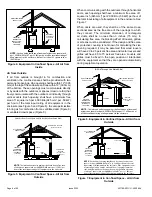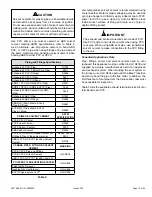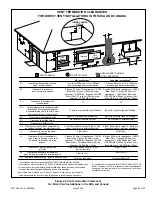
507769-05G / 31-5000656
Page 15 of 55
Issue 2223
NOTE:
Assembly should be completed within 20
seconds after last application of cement. Hammer
blows should not be used when inserting pipe.
8.
After assembly, wipe excess cement from pipe at end
of fitting socket. A properly made joint will show a bead
around its entire perimeter. Any gaps may indicate
an improper defective assembly due to insufficient
solvent.
9. Handle joints carefully until completely set.
Exhaust Piping
1. In areas where piping penetrates joist or interior walls,
hole must be large enough to allow clearance on all
sides of pipe through center of hole using a hanger.
2. When furnace is installed in a residence where unit
is shut down for an extended period of time, such
as a vacation home, make provisions for draining
condensate collection trap and lines.
3. Route piping to outside of structure. Continue with
installation following instructions given in piping
termination section.
Do not discharge exhaust into an existing stack or
stack that also serves another gas appliance. If vertical
discharge through an existing unused stack is required,
insert PVC pipe inside the stack until the end is even
with the top or outlet end of the metal stack.
CAUTION
The exhaust vent pipe operates under positive pressure
and must be completely sealed to prevent leakage of
combustion products into the living space.
CAUTION
Vent Piping Guidelines
This gas furnace can be installed as either a Non-Direct
Vent or a Direct Vent gas central furnace.
NOTE:
In non-Direct Vent installations, combustion air is
taken from indoors and flue gases are discharged outdoors.
In Direct Vent installations, combustion air is taken from
outdoors and flue gases are discharged outdoors.
Intake and exhaust pipe sizing - Size pipe according to
Table 6 and Table 7A through Table 7D. Table 6 lists the
minimum vent pipe lengths permitted. Table 7A through
Table 7D list the maximum pipe lengths permitted.
Regardless of the diameter of pipe used, the standard roof
and wall terminations described in section Exhaust Piping
Terminations should be used. Exhaust vent termination
pipe is sized to optimize the velocity of the exhaust gas as
it exits the termination.
In some applications which permit the use of several
different sizes of vent pipe, a combination vent pipe may
be used. Contact GEA for assistance in sizing vent pipe in
these applications.
Venting Practices
Figure 19. Piping Suspension Guidelines
* See Table 4 for allowable pipe.
NOTE:
Isolate piping at the point where it exits the outside wall or
roof in order to prevent transmission of vibration to the structure.
SCHEDULE 40
PVC − 5’
all other pipe* − 3’
Wall
e
d
i
s
t
u
o
e
d
i
s
n
i
24" maximum
3/4" minimum
Wall Thickness Guidelines
insulation
(if required)
Figure 20.
CHIMNEY
OR GAS
VENT
(Check sizing
for remaining
appliance)
FURNACE
(Removed from
from common
vent system)
WATER
HEATER
OPENINGS
(To Adjacent
Room)
REPLACING FURNACE THAT
WAS PART OF A COMMON
VENT SYSTEM
If this gas furnace replaces a furnace which was
commonly vented with another gas appliance,
the size of the existing vent pipe for that gas appliance
must be checked. Without the heat of the original
furnace flue products, the existing vent pipe is
probably oversized for the single water heater or
other appliance. The vent should be checked for
proper draw with the remaining appliance.








































